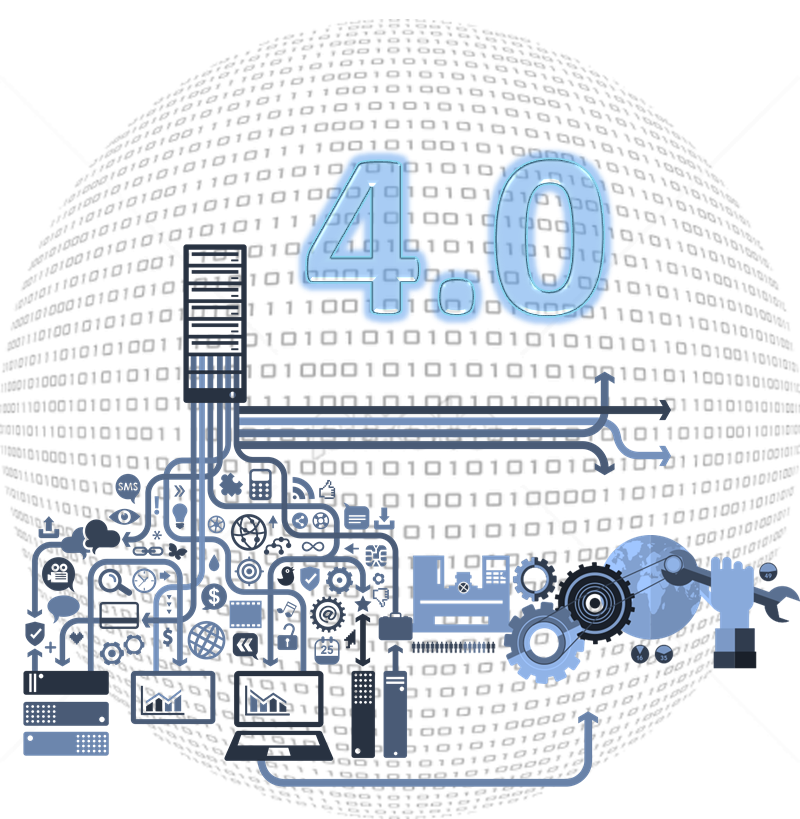Industry 4.0 is a term coined by the German government as shorthand for the Fourth Industrial Revolution. Analysts from the Boston Consulting Group (BCG) explain the first three revolutions were driven by steam, electricity, and automation. They write, “Industrial production was transformed by steam power in the nineteenth century, electricity in the early twentieth century, and automation in the 1970s.”[1] The fourth revolution is being driven by data. The BCG analysts explain, “Today, another workforce transformation is on the horizon as manufacturing experiences a fourth wave of technological advancement: the rise of new digital industrial technologies that are collectively known as Industry 4.0.” Like many revolutions, the fourth industrial revolution is taking a number of years to unfold. Leonardo Vieira, digital industry director with Stefanini Group, explains, “Industry 4.0 isn’t a new term. Remarkably, the cluster of technologies it describes — which includes cyber-physical systems, the Internet of Things (IoT), cloud computing and cognitive computing/artificial intelligence (AI) — is nearly 10 years old.”[2]
Vieira goes on to explain that Industry 4.0 is not just about technology. He writes, “While significant technical advances continue to be made on a nearly daily basis, many of the most exciting developments in this space have less to do with the technology itself, and more to do with how that tech is integrated and applied to optimize utility and maximize impact.” For a revolution to take hold and have legs, it must include people, processes, and technology. That’s why Industry 4.0 is often equated to digital transformation. As Vieira explains, “The coveted digitalization or digital transformation that many companies are striving for requires not just the technical architecture, but also a deeper understanding of how to leverage the unique potential of Industry 4.0 technology. It begins with recognizing that seamless integration, real-time communication and the ability to create manufacturing environments that are virtual, interchangeable, more decentralized and more modular has the potential to radically reshape the industry landscape.”
Industry 4.0 Begins with Data
“Whether it’s control data or preventive maintenance, IoT or cables,” writes Rob Spiegel (@RobSpiegel1), a Senior Editor at Design News, “data is the heart of the digital transformation. The critical factor in the success of Industry 4.0 or advanced manufacturing is data.”[3] Carl Smith, manufacturing solutions manager at IMAGINiT, told Spiegel that the first thing manufacturers need to do is figure out what data is important. Good answers always start with good questions. “You start at the front,” Smith told Spiegel. “What do you need to know about your business? Do you need to know how many products you’re making? How much do they cost? What’s the lead time? And what data makes that clear?” said Smith. “I need information from human resources. I need to harvest data from the website, from customer feedback. It all starts at the front end. What information do I need, and where do I get that information from?” Spiegel observes that a lack of data is generally not the problem. In fact, he notes, most manufacturers are swimming in data; which makes identifying the most important data an even greater challenge.
Despite the fact that many consultants insist industrial age organizations need to transform into digital age enterprises in order to survive, many organizations don’t seem to take the “transformation” part of the advice seriously enough. Tricia Wang (@triciawang), a self-described Tech Ethnographer & Sociologist, explains, “A lot of companies treat digital as if they are ‘doing digital’ — this is ‘digitization’ at its worst — as if it’s some checklist of things to do. It’s very transactional, and people are so busy doing digital they don’t even know WHY they are doing it in the first place! Whereas [some companies] embrace ‘being digital’ — this is ‘digital transformation’ at its best — it’s a total paradigm shift in the culture and operations — it’s not just about buying the latest digital tool, but about creating a new system, new cadence, new mindset.”[4] That’s why I say Industry 4.0 begins with data. The fourth industrial revolution won’t be fully realized until manufacturers take that data and transform their operations.
The Future of Industry 4.0
No two transformation journeys will be alike — so looking for, rather than developing, a template, is a fool’s errand. Nevertheless, Peter Fretty (@pfretty), the technology editor at IndustryWeek, asserts, “The pandemic placed an intense focus on the importance of a few key qualities.”[5] The two most important qualities, he believes, are smart decisions and adaptability.
Smart decisions. Fretty isn’t the first observer to note the importance of smart decision-making. Bain analysts, Michael C. Mankins and Lori Sherer (@lorisherer), assert, “The best way to understand any company’s operations is to view them as a series of decisions.”[6] They add, “We know from extensive research that decisions matter — a lot. Companies that make better decisions, make them faster and execute them more effectively than rivals nearly always turn in better financial performance. Not surprisingly, companies that employ advanced analytics to improve decision making and execution have the results to show for it.” Fretty adds, “Everything is ‘smart’ today, in part because everything within today’s operating environments boasts connectivity. However, connectivity and even data collection are not enough. How manufacturers leverage the insights connectivity can yield is the true difference-maker. Simply put, manufacturers need to be smart.”
Adaptability. Charles Darwin’s theory of evolution underscored the fact that the species most likely to survive are the ones best able to adapt to changing circumstances. The same holds true for businesses. During the pandemic, successful businesses have been able to pivot to meet new demands. Sanjay Poonen (@spoonen), Chief Operating Officer at VMware, observes, “Some companies were able to meet the new demands from their customers and grow their businesses. They include DoorDash, Target, Home Depot, Panera Bread, Beyond Meat, Tesco, Lidl, Aldi, DBS Bank, Zoom, Square, DocuSign, and many more. It became a matter of business survival while also responding to the needs of a population with limited mobility and healthcare concerns. In many cases, what drove their successful growth was the ability to interact with their customers online, through cloud-based mobile apps or curbside pickup. From a technology perspective, the main drivers were apps and cloud.”[7] None of the businesses he mentions were manufacturers; however, his point is as true for manufacturers as it is for other enterprises. Poonen adds, “People often scoff at ‘digital transformation’ as the latest fad. However, what we saw from these companies was the true impact of ‘going digital.’ Every business is now defined by the digital services built to better serve their customers, markets and workforce.”
Concluding Thoughts
Fretty reports a survey conducted by IndustryWeek concluded digital transformation isn’t optional.[8] He writes, “Digital transformation is not a new concept. It has been brewing for years with many companies [trying] to wrap their heads around what it actually means, what it will cost and how long it will take to realize a return on the investment. … As success stories started bubbling to the surface now and then, the number of skeptics started to wane.” As result, Fretty notes, 63% of manufacturers are now involved in digital transformation efforts — with learning how to leverage cognitive technologies as a top priority. Fretty concludes, “Manufacturers clearly understand the costs associated with not embarking on modernization efforts. Specifically, respondents noted a failure to move away from legacy applications in the next two to three years, will cause employee turnover (100%) and lack of ability to compete (67%). Additionally, respondents identify inability to meet new regulations, inability to meet new demands and reduced levels of customer service as consequences for manufacturers of delaying modernization efforts.” Industry 4.0 may be a decade old, yet it remains in its early stages. The faster manufacturers are able to transform, the more likely they are to reap the rewards the Fourth Industrial Revolution offers.
Footnotes
[1] Markus Lorenz, Michael Rüßmann, Rainer Strack, Knud Lasse Lueth, and Moritz Bolle, “Man and Machine in Industry 4.0,” bcg.perspectives, 28 September 2015.
[2] Leonardo Vieira, “The Future of Industry 4.0,” Supply & Demand Chain Executive, 6 April 2021.
[3] Rob Spiegel, “The Future of Manufacturing is Data,” Design News, 3 December 2020.
[4] Trevor Miles, “Let’s be clear: Digitization is not the same as Digital Transformation,” Kinaxis Blog, 8 December 2017.
[5] Peter Fretty, “The Real Future of the Factory,” IndustryWeek, 2 March 2021.
[6] Michael C. Mankins and Lori Sherer, “Creating value through advanced analytics,” Bain Brief, 11 February 2015.
[7] Sanjay Poonen, “Why Digital Transformation Is the ‘Invisible Hand’ of Our Time,” Channel Futures, 19 April 2021.
[8] Peter Fretty, “Survey Says: Digital Transformation Isn’t Optional,” IndustryWeek, 14 July 2021.





